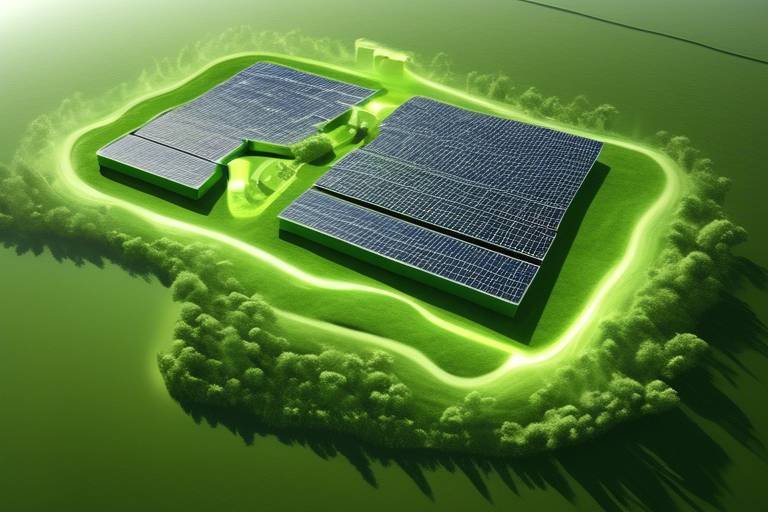Unlocking the Power of the Sun for a Sustainable Tomorrow
In a world increasingly aware of the environmental challenges we face, solar energy emerges as a beacon of hope. The sun, a massive ball of energy, shines down on us every day, offering a clean, renewable resource that can power our homes, businesses, and even entire cities. Imagine harnessing that energy, reducing our reliance on fossil fuels, and paving the way for a sustainable future. This article explores the potential of solar energy as a sustainable solution for our energy needs, examining its benefits, technologies, and future prospects.
Solar energy is crucial in combating climate change and reducing reliance on fossil fuels. By understanding its significance, we can appreciate its role in creating a sustainable future. The urgency of transitioning to renewable energy sources cannot be overstated. With rising global temperatures and increasingly erratic weather patterns, the time to act is now. Solar energy stands out as a practical solution, offering not just a reduction in greenhouse gas emissions but also a pathway towards energy independence.
Various solar technologies exist, each with unique applications and advantages. These technologies contribute to the diverse landscape of solar energy solutions, making it accessible for different needs. The two primary categories are photovoltaic (PV) systems and solar thermal systems. Understanding these technologies can help us make informed decisions about our energy consumption and investments.
Photovoltaic systems convert sunlight directly into electricity using solar cells. These systems are becoming increasingly popular in both residential and commercial sectors due to their efficiency and decreasing costs. As technology advances, more people are realizing that going solar is not just an environmental choice but also a smart financial decision. With the right installation, homeowners can significantly reduce their energy bills and even earn money through net metering.
When considering solar energy, it's essential to understand the difference between grid-tied and off-grid systems. Grid-tied systems connect to the electrical grid, allowing users to draw power when needed and send excess energy back to the grid, often resulting in credits on their utility bills. On the other hand, off-grid systems operate independently, relying on battery storage to provide power when solar generation is low. Each system has its benefits, and the right choice depends on individual circumstances and energy needs.
Innovation is at the heart of the solar industry. Emerging technologies, such as bifacial panels and thin-film solar cells, are enhancing efficiency and reducing costs. Bifacial panels capture sunlight on both sides, maximizing energy production, while thin-film solar cells offer flexibility and lightweight options for various applications. These advancements not only improve the performance of solar systems but also make solar energy accessible in more settings, from rooftops to remote locations.
While photovoltaic systems convert sunlight into electricity, solar thermal systems harness sunlight to produce heat. These systems are primarily used for water heating and space heating, making them an excellent choice for residential and commercial applications. By utilizing solar thermal energy, users can significantly reduce their energy consumption and lower utility bills. With the growing demand for sustainable heating solutions, solar thermal technologies are becoming increasingly relevant.
Solar energy offers significant environmental advantages, including reduced greenhouse gas emissions and lower air pollution levels. By shifting towards solar, we can make a substantial impact on our planet's health. The transition to renewable energy sources like solar is not just a trend; it's a necessity for global sustainability efforts. The more we embrace solar energy, the healthier our planet becomes.
By reducing reliance on fossil fuels, solar energy improves air quality. Cleaner energy sources contribute to healthier communities and ecosystems. Imagine breathing in fresh air instead of smog-filled skies; that’s the promise of solar energy. As we adopt solar solutions, we can expect a significant decrease in pollutants that harm our health and the environment.
Solar energy helps conserve water and other natural resources, mitigating the environmental impact of traditional energy production. Unlike fossil fuel extraction, which can deplete our vital resources, solar technologies utilize the abundant energy from the sun without straining our water supplies. This resource-saving potential is crucial as we look to sustain our planet for future generations.
The future of solar energy looks promising, with ongoing advancements and increasing adoption rates. As technology evolves, we can expect even more efficient and affordable solar solutions. The landscape is changing rapidly, and with it comes the potential for a cleaner, more sustainable world. The question is, are we ready to embrace this change?
Government incentives play a crucial role in promoting solar energy adoption. Various policies and programs, such as tax credits and rebates, support the growth of the solar industry. These incentives not only make solar installations more affordable but also encourage innovation and investment in renewable energy. As governments worldwide recognize the importance of sustainability, we can expect more supportive policies to emerge.
As more countries invest in solar energy, global trends indicate a shift towards sustainable practices. The driving forces behind this transition include technological advancements, decreasing costs, and a collective awareness of climate change. Countries that prioritize solar energy are not just investing in their energy future; they are setting an example for others to follow. This global movement towards solar adoption is reshaping our energy landscape for the better.
- What is solar energy? Solar energy is the energy harnessed from the sun's rays, which can be converted into electricity or heat.
- How does solar energy benefit the environment? It reduces greenhouse gas emissions, improves air quality, and conserves natural resources.
- What are the main types of solar technologies? The main types are photovoltaic systems and solar thermal systems.
- Can I go off-grid with solar energy? Yes, off-grid solar systems allow you to generate your own power independently from the electrical grid.
- Are there government incentives for solar energy? Yes, many governments offer tax credits, rebates, and other incentives to encourage solar energy adoption.

The Importance of Solar Energy
Solar energy is not just a buzzword; it's a vital component in the fight against climate change and the transition towards a more sustainable future. As we grapple with the consequences of fossil fuel consumption, such as rising temperatures and extreme weather events, understanding the significance of solar energy becomes increasingly crucial. Imagine a world where our energy needs are met by the very sun that shines down on us every day—this is not just a dream, but a potential reality.
The benefits of solar energy extend far beyond just reducing our carbon footprint. By harnessing the power of the sun, we can achieve a multitude of environmental and economic advantages. For starters, solar energy is a renewable resource, meaning it won't run out as long as the sun is shining. In contrast, fossil fuels are finite and will eventually deplete, leading to increased competition and conflict over these dwindling resources.
Moreover, solar energy can lead to job creation. The solar industry has been one of the fastest-growing sectors in recent years, offering numerous employment opportunities in manufacturing, installation, and maintenance. This growth not only contributes to local economies but also supports a shift towards green jobs, which are essential for a sustainable future.
Additionally, solar energy promotes energy independence. By investing in solar technologies, countries can reduce their reliance on imported fossil fuels, thereby enhancing their energy security. This shift not only stabilizes energy prices but also protects nations from the volatility of global oil markets.
To highlight its importance, let's take a look at some key statistics:
| Year | Global Solar Capacity (GW) | Reduction in CO2 Emissions (Million Tons) |
|---|---|---|
| 2015 | 227 | 50 |
| 2020 | 773 | 200 |
| 2023 | 1,200 | 300 |
As we can see from the table above, the growth in global solar capacity has a direct correlation with the reduction of CO2 emissions. This trend not only underscores the effectiveness of solar energy in combating climate change but also emphasizes the urgent need for greater adoption of this clean energy source.
In conclusion, the importance of solar energy cannot be overstated. It offers a pathway to a sustainable future, with benefits that encompass environmental, economic, and social dimensions. As we continue to explore and invest in solar technologies, we pave the way for a cleaner, greener planet for generations to come. So, why not embrace this golden opportunity and let the sun power our lives?
- What is solar energy? Solar energy is the energy harnessed from the sun's rays, which can be converted into electricity or heat.
- How does solar energy benefit the environment? It reduces greenhouse gas emissions, improves air quality, and conserves natural resources.
- Is solar energy cost-effective? Yes, while the initial investment can be high, the long-term savings on energy bills and government incentives make it an economically viable option.

Types of Solar Technologies
When it comes to harnessing the power of the sun, there are several solar technologies that stand out, each with its unique applications and advantages. Understanding these technologies is essential for anyone looking to invest in solar energy or simply learn more about how we can tap into this abundant resource. The two primary categories of solar technologies are photovoltaic (PV) systems and solar thermal systems, and each plays a significant role in the renewable energy landscape.
Photovoltaic systems are perhaps the most well-known solar technology. They work by converting sunlight directly into electricity using semiconductor materials, usually silicon. When sunlight hits the photovoltaic cells, it excites electrons, generating a flow of electricity. This technology has seen remarkable advancements in efficiency and affordability over the past few years. As a result, more homeowners and businesses are opting for PV systems, leading to a surge in installations worldwide.
On the other hand, solar thermal systems focus on harnessing sunlight to produce heat rather than electricity. This technology is primarily used for water heating and space heating. Solar thermal systems typically utilize collectors that absorb sunlight and transfer that energy to a fluid, which is then used for heating purposes. This technology is particularly effective in residential settings, where it can significantly reduce energy costs for heating water, especially in sunny regions.
To better understand the differences between these technologies, let's break them down further:
| Technology Type | Function | Common Applications |
|---|---|---|
| Photovoltaic Systems | Converts sunlight into electricity | Residential and commercial electricity generation |
| Solar Thermal Systems | Uses sunlight to produce heat | Water heating, space heating |
But wait, there's more! Within the realm of photovoltaic systems, we also have various subcategories that cater to different needs and preferences. For instance, thin-film solar cells are lightweight and flexible, making them ideal for unconventional surfaces, while bifacial panels can capture sunlight from both sides, enhancing efficiency. The innovation doesn't stop there; new technologies continue to emerge, further expanding the possibilities for solar energy utilization.
In summary, the diverse landscape of solar technologies offers a wealth of options for anyone looking to harness the sun's energy. Whether you're interested in generating electricity through photovoltaic systems or utilizing solar thermal systems for heating, there's a solution that fits your needs. As we continue to explore these technologies, the potential for a sustainable future powered by the sun becomes increasingly attainable.
- What is the difference between photovoltaic and solar thermal systems?
Photovoltaic systems convert sunlight into electricity, while solar thermal systems use sunlight to generate heat. - How efficient are solar panels?
Efficiency varies by technology, but modern photovoltaic panels can achieve efficiencies of over 20%. - Can solar energy be used in cloudy weather?
Yes, solar panels can still generate electricity on cloudy days, although the output may be reduced. - What are the costs associated with installing solar technologies?
Costs vary based on the type of system, installation size, and location, but many governments offer incentives to reduce upfront expenses.

Photovoltaic Systems
Photovoltaic systems are like the superheroes of the solar energy world, transforming sunlight into electricity with remarkable efficiency. But how do they actually work? At their core, photovoltaic (PV) systems utilize solar cells made from semiconductor materials, typically silicon. When sunlight hits these cells, it excites electrons, generating a flow of electricity. This process is known as the photovoltaic effect.
The efficiency of these systems has improved significantly over the years, with modern PV panels reaching efficiencies of over 20%. This means that they can convert more sunlight into usable electricity, making them a viable option for both residential and commercial applications. For homeowners, installing a PV system can lead to substantial savings on electricity bills, while businesses can benefit from reduced operational costs and a greener image.
But the benefits of photovoltaic systems extend beyond just financial savings. They contribute to a cleaner environment by reducing dependence on fossil fuels, which are notorious for their greenhouse gas emissions. By harnessing the power of the sun, we can significantly lower our carbon footprint and help combat climate change. Moreover, the technology is becoming increasingly accessible, with many states and countries offering incentives and rebates to encourage solar adoption.
When considering a photovoltaic system, one must also understand the differences between grid-tied and off-grid systems. Grid-tied systems are connected to the electrical grid, allowing homeowners to draw power from the grid when their solar panels aren't producing enough energy, such as during cloudy days or at night. This setup typically requires less battery storage, making it a more cost-effective option for many. On the other hand, off-grid systems operate independently of the grid, relying on battery storage to provide electricity at all times. This option is ideal for remote areas where connecting to the grid is impractical or too expensive.
As technology progresses, we are witnessing the emergence of innovative solutions in the photovoltaic realm. Bifacial solar panels, for instance, can capture sunlight from both sides, increasing overall energy production. Thin-film solar cells, which are lighter and more flexible than traditional silicon panels, offer new possibilities for integration into various surfaces, including building materials and even clothing. These advancements not only enhance the efficiency of photovoltaic systems but also reduce costs, making solar energy even more accessible to the average consumer.
In summary, photovoltaic systems represent a powerful tool in our quest for sustainable energy solutions. With their ability to convert sunlight into electricity efficiently, coupled with ongoing technological advancements, they hold the promise of a cleaner, greener future. As more people and businesses recognize the benefits of solar energy, the adoption of photovoltaic systems is expected to continue its upward trajectory, paving the way for a sustainable tomorrow.
- What is the lifespan of a photovoltaic system? Most PV systems have a lifespan of 25 to 30 years, with many manufacturers offering warranties for this duration.
- How much maintenance do photovoltaic systems require? Generally, PV systems require minimal maintenance. Regular cleaning and occasional inspections are usually sufficient to keep them functioning optimally.
- Can I install a photovoltaic system on my roof? Yes! Most roofs can accommodate solar panels, but it's essential to consult with a professional to assess your specific situation.
- Are there financial incentives for installing solar panels? Many governments offer tax credits, rebates, and other incentives to encourage solar adoption, making it more affordable for homeowners and businesses.

Grid-Tied vs. Off-Grid Systems
When diving into the world of solar energy, one of the most significant decisions you'll face is choosing between grid-tied and off-grid systems. Each system has its own set of advantages and challenges, making it essential to understand how they operate and which one suits your energy needs best. So, what exactly are these systems, and how do they differ?
Grid-tied systems are connected to the local electrical grid, allowing you to draw power from it when your solar panels aren't producing enough electricity, such as during cloudy days or at night. This setup not only provides a reliable energy source but also enables you to sell excess energy back to the grid, often through a process called net metering. Imagine being able to power your home with sunshine during the day and still having the grid as a safety net when needed! This flexibility is one of the primary reasons homeowners opt for grid-tied systems.
On the other hand, off-grid systems operate independently of the electrical grid. These systems are ideal for remote locations where connecting to the grid would be impractical or too costly. With off-grid systems, you rely entirely on your solar panels and battery storage to meet your energy needs. Think of it like living on an island where you have to generate your own power—it's liberating but requires careful planning and management. Off-grid systems often involve larger battery banks to store energy for use during non-sunny periods, which can lead to higher upfront costs.
To help you visualize the differences, here's a quick comparison:
| Feature | Grid-Tied Systems | Off-Grid Systems |
|---|---|---|
| Connection | Connected to the electrical grid | Independent from the grid |
| Energy Storage | Usually not required (uses grid as backup) | Requires battery storage |
| Cost | Generally lower upfront costs | Higher initial investment due to batteries |
| Net Metering | Available (sell excess energy) | Not applicable |
| Reliability | More reliable due to grid support | Can be less reliable without proper battery management |
Ultimately, the choice between grid-tied and off-grid systems boils down to your specific needs, location, and budget. If you live in a place with a reliable grid and want to maximize the benefits of solar energy without investing heavily in battery storage, a grid-tied system might be the way to go. However, if you're seeking energy independence and live in a remote area, an off-grid system could provide the autonomy you desire. Each option has its own unique benefits, so it's crucial to assess your priorities before making a decision.
- What is the main advantage of a grid-tied system?
The primary advantage is the ability to draw power from the grid when solar production is low, ensuring a constant energy supply. - Are off-grid systems more expensive?
Yes, off-grid systems typically have higher upfront costs due to the need for battery storage. - Can I switch from a grid-tied to an off-grid system?
Yes, but it may require significant modifications and investments in battery storage and other equipment. - How do I decide which system is right for me?
Consider factors such as your location, energy needs, and budget. Consulting with a solar energy expert can also provide valuable insights.

Emerging Technologies in Photovoltaics
As we stride into an era where sustainability is not just a buzzword but a necessity, the field of photovoltaics is experiencing a remarkable evolution. The innovations in solar technology are akin to a thrilling roller coaster ride—full of twists, turns, and exhilarating breakthroughs. Among the most exciting advancements are bifacial solar panels and thin-film solar cells, both of which are revolutionizing how we harness solar energy.
Bifacial solar panels, for instance, are a game-changer. Unlike traditional panels that only capture sunlight from one side, bifacial panels absorb light from both sides. This dual absorption capability means they can generate more electricity, especially in reflective environments like snowy or sandy areas. Imagine the potential: a solar panel that not only captures the sun's rays but also utilizes the light bouncing off the ground below. This innovation can increase energy production by up to 30%, making it a compelling option for both residential and commercial installations.
On the other hand, thin-film solar cells are making waves due to their lightweight and flexible nature. These cells can be integrated into a variety of surfaces, from building materials to clothing. The versatility of thin-film technology means that solar energy can be harvested in places we never thought possible. For example, imagine a building facade that not only looks stunning but also generates electricity. This is not just a dream; it’s becoming a reality thanks to ongoing research and development in this field.
Moreover, the efficiency of these emerging technologies is continuously improving. The latest breakthroughs have led to efficiency rates that are closing in on traditional silicon-based panels. As these technologies become more mainstream, they are also becoming more affordable, which is essential for widespread adoption. The cost of solar energy has already dropped significantly over the past decade, and with new innovations, we can expect even more reductions in the future.
But it’s not just about efficiency and cost; the environmental impact of these technologies is also noteworthy. Bifacial panels and thin-film cells require less material to produce and can be manufactured with fewer resources, which aligns perfectly with our global sustainability goals. As we strive to combat climate change, these advancements are not just technical achievements; they are vital steps toward a cleaner, greener planet.
In conclusion, the future of photovoltaics is bright—pun intended! With technologies like bifacial panels and thin-film solar cells leading the charge, we are on the brink of a solar revolution. These innovations promise not only to enhance energy production but also to make solar energy more accessible and sustainable for everyone. As we embrace these emerging technologies, we are paving the way for a future where solar energy plays a pivotal role in our lives.
- What are bifacial solar panels? Bifacial solar panels are solar panels that can capture sunlight from both sides, increasing energy production.
- How do thin-film solar cells work? Thin-film solar cells are made by depositing one or more thin layers of photovoltaic material on a substrate, making them lightweight and flexible.
- Are these technologies cost-effective? Yes, ongoing advancements are making bifacial and thin-film solar technologies more affordable, encouraging broader adoption.
- What is the environmental impact of these technologies? They require fewer materials to produce and can help reduce greenhouse gas emissions, contributing to global sustainability efforts.

Solar Thermal Systems
Solar thermal systems are an exciting and effective way to harness the power of the sun, primarily focusing on converting sunlight into heat. Unlike photovoltaic systems that generate electricity, these systems utilize solar collectors to absorb sunlight and transform it into thermal energy. This energy can then be used for various applications such as water heating, space heating, and even industrial processes. Imagine basking in the warmth of the sun while simultaneously heating your water or home—it's a win-win!
At the heart of solar thermal systems are solar collectors, which come in several types, including flat-plate collectors and evacuated tube collectors. Flat-plate collectors are typically used for residential heating needs, as they are simpler and less expensive to install. They consist of a dark absorber plate that captures sunlight and a transparent cover that minimizes heat loss. On the other hand, evacuated tube collectors are more efficient and are often used in colder climates or for larger-scale applications due to their superior insulation properties.
The operational principle behind these systems is relatively straightforward. When sunlight hits the collector, it heats a fluid (usually water or a glycol mixture) that circulates through the system. This heated fluid can then be used directly or stored in a tank for later use. For instance, in a residential setting, a solar thermal system can provide hot water for showers, cooking, and even heating the home during chilly months. The efficiency of these systems can be impressive, often reaching up to 70-80% under optimal conditions!
When considering the installation of solar thermal systems, it's essential to evaluate factors such as location, available space, and specific heating needs. For example, a home in a sunny region may benefit significantly from a solar water heating system, while larger commercial buildings might opt for more extensive solar thermal setups to meet their heating demands. The versatility of these systems makes them suitable for various applications, from residential homes to large-scale industrial facilities.
However, like any technology, solar thermal systems come with their challenges. Initial installation costs can be a barrier for some, although government incentives and rebates can help offset these expenses. Additionally, the efficiency of solar thermal systems can be affected by factors such as weather conditions and geographic location. For instance, areas with less sunlight may not see the same energy savings as those basking in sunshine year-round.
| Type of Collector | Efficiency | Best Use |
|---|---|---|
| Flat-Plate Collectors | 60-70% | Residential Heating |
| Evacuated Tube Collectors | 70-80% | Commercial and Industrial Applications |
In summary, solar thermal systems represent a fantastic opportunity to leverage renewable energy for heating needs. As technology advances and more people become aware of the benefits, we can expect to see an increase in their adoption. By tapping into the sun's energy, we not only reduce our reliance on fossil fuels but also take a significant step towards a more sustainable and environmentally friendly future.
- What is the main difference between solar thermal and photovoltaic systems? Solar thermal systems convert sunlight into heat, while photovoltaic systems convert sunlight into electricity.
- How much energy can a solar thermal system save? The energy savings depend on the system's size, location, and usage, but many homeowners report significant reductions in their energy bills.
- Are solar thermal systems suitable for all climates? While they are most effective in sunny regions, solar thermal systems can still work in less sunny areas, especially with advanced collectors like evacuated tubes.

Environmental Benefits of Solar Energy
Solar energy isn't just a buzzword; it's a game-changer for our planet! One of the most compelling reasons to harness the sun's rays is the significant environmental benefits it offers. By transitioning to solar energy, we can dramatically reduce our carbon footprint, combat climate change, and promote a healthier ecosystem. Imagine a world where our energy sources are clean and renewable—sounds dreamy, right? Well, it’s becoming a reality!
First and foremost, solar energy helps in reducing greenhouse gas emissions. Traditional energy sources, like coal and natural gas, release a plethora of harmful gases into the atmosphere. In contrast, solar energy systems produce electricity without emitting carbon dioxide or other pollutants. This shift can lead to a cleaner atmosphere, which is essential for combating global warming. In fact, studies show that if we ramped up solar energy adoption, we could cut down emissions by millions of tons each year!
Moreover, solar energy contributes to lower air pollution levels. The burning of fossil fuels not only affects the climate but also deteriorates air quality, leading to serious health issues like respiratory diseases and cardiovascular problems. By relying on solar power, we can significantly improve air quality, leading to healthier communities. Cleaner air means fewer hospital visits and a better quality of life for everyone.
Another noteworthy aspect of solar energy is its ability to conserve natural resources. Traditional energy production methods often consume vast amounts of water, especially in coal and nuclear plants. However, solar energy systems require minimal water for operation, which is a huge advantage in water-scarce regions. By utilizing solar power, we can alleviate the strain on our precious water resources and promote sustainability. This conservation extends to other resources as well, as solar panels are built to last, reducing the need for frequent replacements and the associated resource extraction.
To illustrate the impact of solar energy on greenhouse gas emissions and air quality, consider the following table:
| Impact Area | Traditional Energy Sources | Solar Energy |
|---|---|---|
| Greenhouse Gas Emissions | High | Zero |
| Water Usage | High | Minimal |
| Air Pollution | Significant | None |
In conclusion, the environmental benefits of solar energy are profound and multifaceted. By embracing this renewable energy source, we not only take a stand against climate change but also promote a healthier planet for future generations. It's not just about energy; it's about creating a sustainable legacy. So, why not join the solar revolution and make a positive impact on our environment?
- What are the main environmental benefits of solar energy? Solar energy helps reduce greenhouse gas emissions, lowers air pollution, and conserves natural resources.
- How does solar energy improve air quality? By replacing fossil fuels with solar energy, we can significantly decrease harmful emissions that contribute to air pollution.
- Is solar energy water-efficient? Yes, solar energy systems use minimal water compared to traditional energy sources, making them a sustainable choice in water-scarce areas.

Impact on Air Quality
The impact of solar energy on air quality is nothing short of revolutionary. Imagine a world where the air we breathe is cleaner, fresher, and free from the toxic pollutants emitted by fossil fuels. With solar energy stepping into the limelight, this vision is becoming a reality. When we harness the power of the sun, we significantly reduce our dependence on conventional energy sources that contribute to air pollution. This shift not only benefits our health but also the health of our planet.
Solar energy systems, such as photovoltaic panels and solar thermal systems, generate electricity and heat without producing harmful emissions. Unlike coal or natural gas power plants, which release carbon dioxide (CO2), sulfur dioxide (SO2), and nitrogen oxides (NOx) into the atmosphere, solar technologies operate in a clean manner. This fundamental difference translates into a marked reduction in greenhouse gases and other air pollutants, leading to improved air quality.
To illustrate the impact, consider the following statistics:
| Pollutant | Reduction Percentage with Solar Energy |
|---|---|
| Carbon Dioxide (CO2) | Up to 80% |
| Nitrogen Oxides (NOx) | Up to 90% |
| Sulfur Dioxide (SO2) | Up to 95% |
These reductions are crucial, especially in urban areas where air quality is often compromised by traffic emissions and industrial activities. By transitioning to solar energy, cities can combat the smog that plagues many metropolitan regions. Moreover, cleaner air leads to healthier communities; studies have shown that improved air quality correlates with lower rates of respiratory diseases, cardiovascular problems, and other health issues.
But the benefits of solar energy extend beyond just human health. Cleaner air contributes to healthier ecosystems. Wildlife, plants, and water bodies all suffer from air pollution, which can lead to acid rain and other environmental problems. When we reduce air pollutants, we help preserve biodiversity and maintain the delicate balance of our ecosystems.
In summary, the impact of solar energy on air quality is profound. By reducing harmful emissions and improving the air we breathe, solar energy not only enhances public health but also supports environmental sustainability. As we continue to embrace this renewable resource, we pave the way for a cleaner, greener future for generations to come.
- How does solar energy improve air quality?
Solar energy reduces reliance on fossil fuels, leading to fewer emissions of harmful pollutants such as CO2, NOx, and SO2. - What are the health benefits of improved air quality?
Cleaner air can lead to lower rates of respiratory and cardiovascular diseases, contributing to overall public health. - Can solar energy help combat climate change?
Yes, by reducing greenhouse gas emissions, solar energy plays a significant role in mitigating climate change effects. - Are there any downsides to solar energy?
While solar energy is largely beneficial, challenges include initial installation costs and the need for appropriate weather conditions.

Conservation of Natural Resources
When we talk about solar energy, one of the most compelling arguments in its favor is the remarkable way it aids in the . Traditional energy sources, such as coal and natural gas, not only deplete these resources but also require vast amounts of water for extraction and processing. In contrast, solar energy harnesses the sun's rays, which are abundant and renewable, allowing us to significantly reduce our environmental footprint.
To put things into perspective, consider this: a typical coal-fired power plant can consume over 2.5 billion gallons of water annually just for cooling purposes. In contrast, solar panels require minimal water for maintenance, primarily needing it for cleaning. This stark difference highlights how solar energy can help conserve precious water resources, especially in arid regions where water scarcity is a pressing issue.
Furthermore, the production of solar energy is not just about reducing water consumption; it also contributes to the preservation of other vital natural resources. For instance, by decreasing our reliance on fossil fuels, we lessen the demand for mining and drilling activities that can lead to habitat destruction and soil degradation. The shift towards solar energy promotes a more sustainable approach to energy production, allowing ecosystems to thrive.
In addition to conserving water and minimizing habitat disruption, solar energy technologies are designed to be resource-efficient. For example, advancements in solar panel manufacturing have led to the development of materials that require less energy to produce. This efficiency not only reduces the carbon footprint associated with their creation but also conserves raw materials such as silicon, which is a primary component of solar cells.
Moreover, as we continue to innovate in the solar energy sector, we are seeing the emergence of recycling programs for solar panels. These initiatives aim to reclaim valuable materials like glass, metals, and silicon from old panels, ensuring that we are not only conserving resources but also minimizing waste. This circular approach to solar technology exemplifies how we can create a sustainable energy ecosystem that respects and preserves our planet's resources.
In summary, the conservation of natural resources through solar energy is a multifaceted benefit that cannot be overlooked. By embracing solar technologies, we are taking significant steps toward a sustainable future, one where our reliance on finite resources diminishes, and our ecosystems flourish. It's not just about generating power; it's about creating a harmonious balance between energy needs and environmental stewardship.
- How does solar energy help conserve water?
Solar energy systems require significantly less water than traditional fossil fuel power plants, which need large amounts of water for cooling and processing. - What materials are used in solar panels?
Solar panels primarily consist of silicon, glass, and metals, which can often be recycled at the end of their lifespan. - Are there recycling programs for solar panels?
Yes, many companies are developing recycling programs to recover valuable materials from old solar panels, promoting sustainability. - How does solar energy impact habitat conservation?
By reducing the demand for fossil fuels, solar energy helps to minimize habitat destruction associated with mining and drilling activities.

The Future of Solar Energy
As we stand on the brink of a new energy revolution, the future of solar energy looks not only promising but downright exciting. With technological advancements and increasing global awareness about the environment, solar energy is poised to play a pivotal role in our quest for sustainable living. Imagine a world where every rooftop is a power plant, generating clean energy while reducing our carbon footprint. This isn't just a dream—it's becoming a reality!
So, what does the future hold for solar energy? One of the most significant trends is the rapid innovation in solar technologies. From enhanced photovoltaic systems to cutting-edge solar thermal solutions, the improvements are staggering. For instance, bifacial solar panels, which capture sunlight on both sides, are becoming more common, significantly increasing energy yields. As these technologies become more efficient and cost-effective, we can expect to see a surge in their adoption across various sectors.
Moreover, the integration of solar energy with smart grid technology is revolutionizing how we consume and manage electricity. Smart grids allow for better energy distribution and storage, making solar energy more reliable and accessible. In fact, many homeowners are now opting for energy storage systems that enable them to store excess energy generated during the day for use at night. This shift not only maximizes energy efficiency but also empowers individuals to take control of their energy consumption.
However, it's not all sunshine and rainbows. The solar industry still faces challenges that could impact its growth trajectory. Issues such as the availability of raw materials, regulatory hurdles, and the need for skilled labor can slow down progress. Yet, with government incentives and policies designed to promote solar energy, these challenges are being addressed. For example, many countries are implementing tax credits and rebates to encourage both residential and commercial solar installations.
Looking at global trends, the adoption of solar energy is on an upward trajectory. According to recent studies, the global solar market is expected to grow exponentially over the next decade, driven by factors such as:
- Increased awareness of climate change
- Technological advancements reducing costs
- Government policies promoting renewable energy
As nations strive to meet their climate goals, solar energy will undoubtedly be at the forefront of these efforts. Countries like Germany, China, and the United States are leading the charge, investing heavily in solar infrastructure and research. This trend is not just limited to developed nations; emerging economies are also recognizing the potential of solar energy as a viable solution to their energy needs.
In conclusion, the future of solar energy is bright, with a landscape rich in potential and opportunity. By embracing innovation, overcoming challenges, and leveraging government support, we can harness the sun's power to create a sustainable and energy-efficient world. The transition to solar energy is not just a trend; it's a necessity for a healthier planet and a more sustainable future.
- What are the main benefits of solar energy? Solar energy reduces greenhouse gas emissions, lowers electricity bills, and decreases reliance on fossil fuels.
- How does solar energy impact the economy? The solar industry creates jobs, stimulates local economies, and attracts investments in renewable energy technologies.
- Can solar energy power my entire home? Yes, with the right system and energy storage solutions, solar energy can provide all the electricity your home needs.
- What are the challenges facing solar energy? Challenges include high initial costs, regulatory issues, and the need for better energy storage solutions.

Government Incentives and Policies
When it comes to fostering the growth of solar energy, play a pivotal role. These measures are designed to encourage both individuals and businesses to invest in solar technologies, thus contributing to a more sustainable energy landscape. Imagine walking into a store and finding a coupon that gives you a significant discount on your favorite product; that's essentially what these incentives do for solar energy! They make it more affordable and accessible to the average consumer.
Various forms of incentives can be seen across the globe, tailored to fit different economic and social contexts. For instance, in the United States, the federal government offers a tax credit known as the Investment Tax Credit (ITC), which allows homeowners and businesses to deduct a substantial percentage of their solar installation costs from their federal taxes. This not only lowers the upfront costs but also accelerates the return on investment for solar installations. In addition to federal incentives, many states provide their own programs, including rebates, grants, and performance-based incentives.
Moreover, policies like net metering allow solar energy users to sell excess energy back to the grid, creating a financial incentive for those who invest in solar systems. This means that when your solar panels produce more energy than you use, you can get compensated for that surplus, effectively reducing your energy bills. It’s like having a side hustle that pays you for being environmentally friendly!
To give you a clearer picture, here’s a simple table that outlines some common government incentives for solar energy across different regions:
| Region | Incentive Type | Description |
|---|---|---|
| United States | Investment Tax Credit (ITC) | Allows deduction of a percentage of solar installation costs from federal taxes. |
| Germany | Feed-in Tariffs | Guarantees fixed payments for solar energy fed into the grid. |
| Australia | Small-scale Technology Certificates (STCs) | Provides certificates that can be traded for cash based on the amount of renewable energy generated. |
| India | Solar Park Scheme | Government facilitates land acquisition and provides financial assistance for solar projects. |
These incentives not only stimulate the market for solar energy but also contribute to the overall goal of reducing carbon emissions. By making solar energy more financially viable, governments are essentially paving the way for a cleaner, greener future. However, it’s essential to keep in mind that the effectiveness of these programs can vary based on local regulations and market conditions. Some areas may have fantastic incentives that make solar energy irresistible, while others might lag behind, making it a bit more challenging for potential adopters.
In conclusion, government incentives and policies are crucial in driving the solar energy revolution. They not only lower the financial barriers for individuals and businesses but also create a supportive environment for the growth of renewable energy. As we continue to face the challenges of climate change and energy sustainability, these initiatives will be vital in shaping a future where solar energy is a mainstream choice for everyone.
- What is the Investment Tax Credit (ITC)? The ITC allows you to deduct a percentage of your solar installation costs from your federal taxes.
- How does net metering work? Net metering lets you sell excess solar energy back to the grid, offsetting your energy bills.
- Are government incentives available in my state? Yes, many states offer their own incentives in addition to federal programs. It's best to check local resources for specific details.
- Can businesses take advantage of solar incentives? Absolutely! Many incentives apply to commercial installations, making solar energy a smart investment for businesses as well.

Global Trends in Solar Adoption
The world is experiencing a remarkable shift towards solar energy, driven by a combination of technological advancements, economic incentives, and an increasing awareness of environmental issues. More countries are recognizing the importance of sustainable energy sources, and solar power is leading the charge. This transformation is not just a trend; it's a necessary evolution in how we generate and consume energy. With the global push for reducing carbon footprints and transitioning to greener alternatives, the adoption of solar energy is becoming more prevalent across various sectors.
One of the most significant trends in solar adoption is the **decreasing cost of solar technology**. Over the past decade, the price of photovoltaic (PV) panels has plummeted, making solar energy more accessible than ever. According to recent data, the cost of solar has dropped by over 80% since 2010. This price reduction has opened the door for households and businesses to invest in solar installations, significantly increasing the number of solar-powered homes and commercial buildings.
Additionally, governments worldwide are implementing policies that encourage solar adoption. These policies often include incentives such as tax credits, rebates, and grants that make solar installations financially attractive. For instance, countries like Germany and China have set ambitious targets for renewable energy, with solar playing a crucial role in their energy mix. This governmental support not only boosts the solar market but also fosters innovation and competition among manufacturers.
Another notable trend is the rise of **community solar projects**. These initiatives allow multiple households or businesses to invest in a shared solar array, making it easier for those who may not have suitable rooftops for solar panels to benefit from solar energy. Community solar is particularly beneficial in urban areas where space is limited, and it promotes inclusivity by allowing more people to participate in the renewable energy movement.
Furthermore, the integration of solar energy with **smart technology** is revolutionizing how we manage energy consumption. Smart grids and energy management systems enable users to monitor their energy usage in real-time, optimizing when to draw power from the grid or utilize stored solar energy. This synergy between solar power and technology not only enhances efficiency but also contributes to a more resilient energy infrastructure.
As we look to the future, the trend of solar adoption is expected to accelerate. With the ongoing advancements in solar technology, such as bifacial panels and solar tracking systems, the efficiency of solar installations will continue to improve. This means that less space will be needed to generate the same amount of energy, making solar a more viable option for urban and densely populated areas.
In summary, the global trends in solar adoption are indicative of a broader shift towards sustainability. The combination of decreasing costs, supportive policies, community initiatives, and technological advancements is paving the way for a solar-powered future. As more countries invest in solar energy, we can expect to see a significant reduction in greenhouse gas emissions and a move towards a cleaner, greener planet.
- What are the main benefits of solar energy? Solar energy reduces electricity bills, lowers carbon emissions, and can increase property value.
- How does solar energy work? Solar panels convert sunlight into electricity through photovoltaic cells, which generate direct current (DC) that is then converted to alternating current (AC) for use in homes and businesses.
- Is solar energy reliable? Yes, solar energy is a reliable source of power, especially in sunny regions. With battery storage, it can provide energy even when the sun isn't shining.
- What is the lifespan of solar panels? Most solar panels have a lifespan of 25 to 30 years, and many come with warranties that guarantee performance over that period.
Frequently Asked Questions
- What is solar energy and why is it important?
Solar energy is the energy harnessed from the sun's rays. It's crucial because it helps combat climate change by reducing our reliance on fossil fuels. By tapping into this abundant resource, we can create a more sustainable future and lower our carbon footprint.
- What are the different types of solar technologies?
There are primarily two types of solar technologies: photovoltaic (PV) systems, which convert sunlight directly into electricity, and solar thermal systems, which use sunlight to generate heat. Each technology has its unique applications and benefits, making them suitable for different energy needs.
- How do photovoltaic systems work?
Photovoltaic systems consist of solar panels made up of many solar cells that convert sunlight into electricity. When sunlight hits these cells, it generates an electric current, which can be used immediately or stored for later use. Their efficiency has been steadily increasing, making them a popular choice for both residential and commercial energy solutions.
- What is the difference between grid-tied and off-grid solar systems?
Grid-tied systems are connected to the electrical grid, allowing users to draw power from the grid when solar production is low. Off-grid systems, on the other hand, operate independently and rely on battery storage to provide power. Choosing between the two depends on your energy needs and location.
- What are some emerging technologies in solar energy?
Emerging technologies in solar energy include bifacial panels, which capture sunlight on both sides, and thin-film solar cells, which are lightweight and flexible. These innovations are enhancing the efficiency and affordability of solar energy, making it more accessible to a broader audience.
- How does solar energy benefit the environment?
Solar energy significantly reduces greenhouse gas emissions and lowers air pollution levels. By using cleaner energy sources, we can improve air quality, promote healthier communities, and conserve natural resources, such as water, which are often depleted in traditional energy production.
- What role do government incentives play in solar energy adoption?
Government incentives, such as tax credits and rebates, are vital for promoting solar energy adoption. These programs can lower the upfront costs of solar installations, making it easier for individuals and businesses to invest in renewable energy solutions.
- What are the global trends in solar energy adoption?
Global trends show an increasing investment in solar energy as countries recognize its potential for sustainable development. Factors driving this shift include technological advancements, decreasing costs, and a growing awareness of the need for clean energy sources to combat climate change.



















